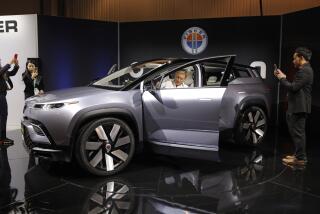GM reorganization may be end of road for Saturn
General Motors Corp. launched its Saturn division in 1985 as a “different kind of car company,” one given the task to sell cars in a new way and compete with Japanese juggernauts like Honda and Toyota.
The idea, simply, was to make money on the small, economical vehicles that had always been losers for the Detroit giant.
Now GM may be abandoning the brand altogether.
The sweeping restructuring plan GM released this week in hopes of squeezing $18 billion in aid out of Congress includes a pledge to “explore alternatives” for Saturn.
GM officials say options include overhauling the lineup, partnering with another carmaker, selling the brand and, potentially, sending Saturn off to the junkyard.
GM’s Swedish luxury brand Saab might also be sold, and Pontiac could be transformed into a “niche” brand inside other dealerships.
But the decision to consider pulling the plug on Saturn, the agile little start-up that GM developed to reinvent the way it produced and sold cars, is a bitter reminder of just how deep the automaker’s troubles run.
Saturn, after all, was created to do almost everything that GM, industry experts and many members of Congress say a modern car company has to do to survive in today’s market: Make a limited range of small, fuel-efficient cars, then sell them through a small network of dealers for a profit.
There was just one hitch: GM says Saturn never made a profit.
At its plant in Spring Hill, Tenn., Saturn made simple, unfussy cars designed to appeal to penny-wise drivers. But the price point of the vehicles -- in recent years as low as $12,000 on some models -- was far too low to cover the cost of producing and marketing them, analysts say.
In response, the company raised prices substantially, to an average of about $17,000 two years ago and about $24,000 today. To accomplish that, however, the company had to stock the lineup with larger, fancier vehicles like the hulking Outlook sport utility vehicle.
The Outlook, which seats eight, starts at $31,000 and seemingly has nothing in common with the no-fuss economy sedans like the S-Series, which debuted in 1991 with a sticker price of $7,995.
“To broadly stereotype, Saturn buyers are single women teachers,” said Eric Noble, president of Car Lab, an industry consulting firm in Orange. “They don’t need an eight-person SUV.”
So far this year, Saturn sales are down 21% from 2007 levels, compared with a 16% drop for the auto industry as a whole.
Two years ago, GM announced plans to bring much of the lineup from its German division, Opel, to the U.S. and rebadge them as Saturns. The idea was to deliver high-styled yet efficient European-made cars that would compete with the likes of the Honda Accord and the Toyota Corolla.
The first such import, the Saturn Astra, arrived on dealer lots in January. But it sells fully loaded for just $21,000, and as the euro skyrocketed against the dollar earlier this year, the Astra became wildly unprofitable at that price.
Through November, 10,813 Astras had been sold, fewer than the BMW 7-series, which starts at $77,000.
Each Astra cost GM “several thousand dollars more than they had anticipated” to get to market, said Ken Croft, general manager of Saturn of Cerritos, the largest Saturn store west of the Mississippi.
Croft’s sales have declined 38% this year, forcing the dealership to combine its new and used-car sales staff and to lay off three salespeople.
On Wednesday morning, the lone customer on his lot was Bob Suhajda, a Los Angeles-area accountant. Suhajda said he preferred U.S.-made cars and would be reluctant to buy a Saturn if it came under foreign ownership.
“I came to Saturn because it’s an American product,” said Suhajda, who was eyeing the Skye convertible, a two-seat roadster. “If a Chinese or Indian company bought it, I would hesitate.”
Mark LaNeve, GM’s vice president for North American sales, service and marketing, said it was too early to be sure of what exactly would be done with Saturn. But in light of the company’s woes, he said, “it’s very difficult to say we can afford the luxury of keeping brands that are not profitable.”
And Saturn, LaNeve added, was never profitable for GM.
To find the black, GM plans to thin Saturn’s dealer ranks, bring in more European cars it could rebrand as Saturns such as the subcompact Opel Agila, and kill existing models like the Aura -- a near carbon-copy of the Chevy Malibu.
If those efforts fail, a sale might be the next option.
That could be complicated, experts say, because Opel has been ramping up production to supply cars to Saturn in the U.S. If the brand is sold, however, GM probably would insist that the buyer absorb those vehicles so that its profitable European unit would not be stuck with a glut of cars.
LaNeve and other GM officials say they hope to avoid a sale. But according to an individual familiar with GM operations, who spoke under condition of anonymity because of a business relationship with the company, GM had already prepared sales prospectuses for both Saturn and Saab long before it delivered its plan to Congress.
The final option, LaNeve said, would be to eliminate the brand, something he says GM does not want to do. That may be partly because its contracts with its 211 dealers (who operate 425 stores) require payouts when a brand is terminated. GM paid more than $1 billion to kill Oldsmobile early this decade.
Another hurdle would be the unusual franchise agreement GM has with Saturn dealers.
With other brands, GM has unilateral decision-making power. But Saturn dealers have eight seats on a 16-member Franchise Operating Team and have a vote in major business moves, such as the decision this year to allow all GM dealers to sell certified pre-owned vehicles from all other GM brands.
That structure gives dealers such as Michael Greene, owner of Saturn of Whittier and Harris Buick Pontiac GMC, some reason for optimism. He lost his Oldsmobile franchise in 2001 when that brand was killed, but in exchange GM helped him acquire the Buick Pontiac GMC franchise.
“I don’t believe that Saturn will go away,” Greene said. “I doubt very seriously they will close a brand they have put this much time and money into.”
One of Saturn’s famously loyal customers is Chelsea Sexton of El Segundo, co-founder of Lightning Rod, which advocates alternative vehicles.
Sexton worked for Saturn in the early days, spending three years as a saleswoman starting in 1993 and staying on with the company in marketing, ultimately working in the development of GM’s first electric car before leaving in 2001.
Now she finds it hard to believe that the brand may go extinct.
“It was one of the only brands that GM has that tried new things and introduced new kinds of products,” said Sexton, who is driving her eighth Saturn. “To kill that off seems absurd.”
--
More to Read
Inside the business of entertainment
The Wide Shot brings you news, analysis and insights on everything from streaming wars to production — and what it all means for the future.
You may occasionally receive promotional content from the Los Angeles Times.










